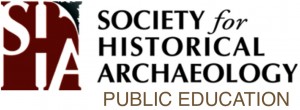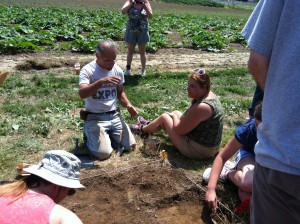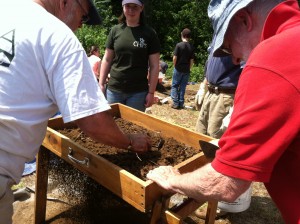
By Mandy Ranslow
State Archaeologist, Dr. Nicholas Bellantoni, has held his post watching over Connecticut’s archaeological resources for the past 27 years. During his tenure he encountered sites ranging from Native American settlements to a World War II plane crash. Throughout his career Dr. Nick has included the public in many ways, speaking regularly about his excavations at historical societies, libraries, and even to Audubon groups. His fieldwork endeavors make use of a large volunteer group who supports his office, the Friends of the Office of State Archaeology (see SHA PEIC Blog November 4, 2013). Part of his job is also teaching introductory archaeology classes at the University of Connecticut, where several students have been known to declare their major as anthropology after completing his class. Even in my own experience the response I get from anyone who hears I’m an archaeologist is, “Do you know Nick Bellantoni?” Dr. Nick is a celebrity in his own right here in Connecticut. A lot of that has to do with his passion for exciting the public about archaeology and his constant outreach efforts.
I caught up with Dr. Nick while he was leading a public dig for teenagers for the Historical Society of Glastonbury.
- I want to share his thoughts on the importance of public outreach and engagement in archaeology:
Dr. Nick was the first State Archaeologist after the Office was legislatively established. Upon starting the job, how important did he think engaging the public would be?
- Dr. Nick knew from the beginning that working with the public would be very important. The public didn’t have any awareness of archaeology, and largely viewed collecting arrowheads as a pastime. At the local level archaeology was seen as a hobby, and the general public didn’t think the archaeological sites in Connecticut were necessarily significant. Dr. Nick realized quickly that public education would be the key to preservation.

FOSA Volunteer Assisting Excavation Participants
Dr. Nick’s schedule has been packed with speaking arrangements in the last several years. Has this always been the case?
- Yes, Dr. Nick has given talks in almost all the state’s historical societies, and the more talks he gives, the more he is asked to do. As Dr. Nick became involved in more projects, he was also extended more invitations to talk about them. The Horton Farm site in Glastonbury (the location of the Historical Society’s dig) was made known to Dr. Nick because Mr. Horton attended a local lecture. Mr. Horton has opened his property to Dr. Nick many times for public excavations. By creating contacts through speaking engagements Dr. Nick has excavated interesting sites throughout the state.

How did Dr. Nick’s relationship with the public evolve over the last 27 years?
- Over Dr. Nick’s tenure he continues to reach new audiences with his message of preservation and archaeology. Keeping local connections is very important. Local officials on Planning and Zoning Boards are made aware of preservation issues through Dr. Nick’s talks. Dr. Nick very much values the freedom the Office of State Archaeology has as an entity outside the State Historic Preservation Office to focus on local engagement outside the state and federal regulatory framework.
How does Dr. Nick maintain the energy and enthusiasm for working with the public?
- Dr. Nick was quick to answer, he “works out.” And his primary motivator is his sense of responsibility to the archaeological record, tribes, and the public. He is also very cognizant of the expectations of the local archaeological community, for which Dr. Nick is the public face. While Dr. Nick is a self-professed workaholic, he does feel privileged (and lucky) to be the State Archaeologist. This drives him to excel at his job.
Many articles have been published in Connecticut lately about Dr. Nick’s celebrated role as State Archaeologist and his favorite excavations. What excavation stands out as successfully including the public? And what excavation is the public most fascinated in still to this day?
- Dr. Nick says the Vampire Dig (highlighted in a 2012 article by the Smithsonian) is still the most asked about by the public even though it took place over twenty years ago. Though a sensational story, Dr. Nick does use the opportunity to also talk about archaeology and forensics in general. “Like a vampire, it never dies.”
What advice do you have for your successor in regards to working with the public?
- Dr. Nick stresses the importance of outreach, and that, “You can never do enough.” The State Archaeologist’s ability to protect sites depends on the public’s interest and excitement in archaeology. This is paramount in doing work at the local level, especially when there is “shaky legislative ground.” The next State Archaeologist (Dr. Brian Jones) will need to establish his own working relationships and “do things his way.” Dr. Brian will also have the continued support of the Friends group. “Public outreach is the key to everything else we do (as archaeologists); it all connects.”
Does Dr. Nick see himself remaining involved in archaeology after his retirement?
- After he “sleeps for the first three months,” yes. Dr. Nick will continue to teach at the University of Connecticut, and he will help with fundraising at the Connecticut State Museum of Natural History. Dr. Nick will also fit in some time for research and finishing up projects. He also hopes to do some writing. Connecticut will continue to benefit from Dr. Nick’s energy and passion for archaeology for a long time to come.
As President of the Friends of the Office of State Archaeology, our volunteers, and all of Dr. Nick’s fans in Connecticut and beyond wish him a happy retirement. Words cannot express the gratitude we have for Dr. Nick’s contributions to Connecticut archaeology.
Who inspires you in the world of public archaeology? What can you do to continue the tradition of public engagement in archaeology in your own backyard? Or what can you do to start a tradition of public outreach yourself?
